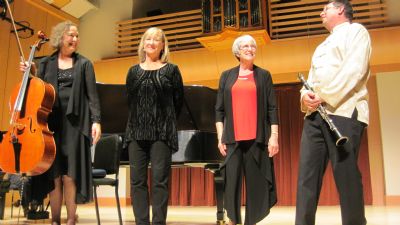|
Symphony
FROM THE NEW WORLD TO THE OLD WORLD
by Peter Lert
Saturday, June 14, 2025
Chamber
MC2 DUO RECITAL CLOSES 222'S SEASON
by Terry McNeill
Saturday, June 14, 2025
Choral and Vocal
CANTIAMO SONOMA'S LUSCIOUS A CAPELLA SINGING IN SEASON ENDING CONCERT
by Pamela Hicks Gailey
Sunday, June 8, 2025
Symphony
SRS SEASON ENDS WITH RESOUNDING TA-TA-TA-BANG
by Terry McNeill
Sunday, June 1, 2025
Symphony
YOUTHFUL VIRTUOSITY ON DISPLAY AT USO'S MAY CONCERTS
by Peter Lert
Saturday, May 17, 2025
Symphony
MYSTICAL PLANETS AND LIVELY GERSHWIN ORTIZ AT FINAL SRS CONCERT
by Peter Lert
Sunday, May 4, 2025
Symphony
VSO'S CONCERT MUSIC OF TIME, MUSIC OF PLACE
by Peter Lert
Sunday, April 27, 2025
VOCAL ELEGANCE AND FIRE AT THE 222'S RECITAL APRIL 26
by Pamela Hicks Gailey
Saturday, April 26, 2025
CANTIAMO SONOMA SINGS AN INSPIRED GOOD FRIDAY MOZART REQUIEM CONCERT
by Pamela Hicks Gailey
Friday, April 18, 2025
DRAMATIC SHOSTAKOVICH SYMPHONY CLOSES PHILHARMONIC'S 25TH SEASON
by Terry McNeill
Sunday, April 13, 2025
|
 |
 (L to R) J. Brindel, K. Reynolds, M. Thompson and R. Zajac Oct. 23 |
TASTY TRIO NAVARRO CONCERT WITH SRS WIND VIRTUOSI
by Terry McNeill
Sunday, October 23, 2016
SSU’s resident Trio Navarro has a long history of presenting diverse programs in the piano trio format, with occasional out-of-area artists joining the mix. This familiar configuration was altered in an Oct. 23 Schroeder Hall concert with the deletion of the violin part and the addition of two sterling local wind players.
The “newbies” jumped right in with pianist Marilyn Thompson in a transcription of Fauré’s six-part Dolly Suite, Op. 56. In the opening “Berceuse” the flute (Kathleen Reynolds) and clarinet (Roy Zajac) parts carried perfectly to the audience of 125, the rich lines covering a tinckeling piano part. The balance improved in the “Mi-a-ou” and “Le Jardin de Dolly” movements, the first with a boisterous ending and the second wholly belonging to Mr. Zajac with his rendering a lovely theme taken from the same composer’s A Major Violin Sonata.
This was everywhere a fetching performance, especially in the “Tendresse” part that featured a slow and melancholic flute-clarinet interplay. The fast Chabrier-like finale (Le Pas Espagnol) was dominated by the piano part and brought the beguiling music to a chirpy end.
Trio co-founder cellist Jill Rachuy Brindel stepped out of her customary ensemble role to play Beethoven’s C Major Sonata, Op. 102, No. 1. Ms. Brindel’s performance was never forceful in power or tone, but featured a focused and lyrical sound that in the Andante-Allegro sporadically was covered in the low register by the piano. This is a piece far removed from the composer’s preceding and dramatic A Major Sonata, but some of it’s energy spilled over into the concluding Allegro Vivace. The duo’s deliberate tempo and strong accents highlighted the movement that had accurate instrumental pitch and elegant phrasing.
French composer Phillipe Gaubert, an early 20th Century colleague of flute master Georges Barrère, wrote his delectable “Trois Aquarelles” for flute, cello and piano, and the work is atmospherically French. Ms. Reynolds, principal Santa Rosa Symphony flutist, played extravagantly in the “Par un clair matin” with a rippling piano part and the cello line uncovering mild dissonances. Ms. Brindel’s vibrato widened and became richer in the “Soir d’automne” with a chaste minor-key ending.
An outdoor and waltz-like “Pipes of Pan” character was heard in the concluding “Sérénade” with Ms. Thompson’s rippling Arpeggios gently supporting the other two instruments.
Mr. Zajack, also a SRS principal, rejoined Ms. Thompson and Ms. Brindel to cap the afternoon with Nino Rota’s Trio, a 16-minute work from 1973 that is individual in ways that the composer’s 150 film scores are not. The Allegro was played percussively and in spots the pace was quite pushed. Unlike this movement, the following Andante had references to seamless film music with lush romantic themes, many slow climaxes and colorful melodies projected by Mr. Zajac and echoed by Ms. Brindel. It was some of the most choice playing of the day.
The concluding Allegrissimo was indeed light and “kittenish,” one instrument playing catch up to another with frequent tasty interjections. It’s derivative music in many ways, with touches of Milhaud and even a lighter sardonic Shostakovich, but no less enjoyable for that. The ensemble was assured and elicited and noisy ovation.
|

